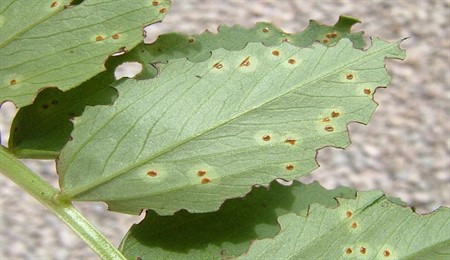On-farm demonstration of fungicide for the control of chocolate spot (Botrytis fabae L.) on faba bean in Bale zone, Ethiopia
Keywords:
Faba bean, Botrytis fabae, Fungicides, Net return, Vicia faba, Moti, Mancozeb 80% WPAbstract
Faba bean (Vicia faba L.) is one of the most important food legumes in the world and in Bale-highlands as well. The experiment was executed for one year at Goba and Dinsho districts with the objectives of demonstrating different fungicide for the control of chocolate spot on faba bean and to give awareness on the use and effectiveness of the fungicide against chocolate spot on faba bean. The experiment was conducted using one faba bean varieties; Moti and two fungicide Mancozeb 80% (2.5 kg/ha) and Odeon 825 WG (2.5 kg/ha). The highest mean chocolate spot severity index recorded was 55% on unsprayed plot and the minimum mean chocolate spot severity index was recorded on Odeon 825 WG sprayed plot 27.5% severity at Goba district. Mancozeb 80% WP sprayed plots gave higher yield 2680 kg/ha and 2490 kg/ha at both locations as compared to Odeon 825 WG and unsprayed plots. Maximum percent of seed yield was increased over check by Mancozeb 80% WP 34.33% at Goba. Mancozeb 80% WP sprayed plot provided the highest gross returns (birr 40,200/ha) and 37,350/ha at Goba and Dinsho, respectively. The lowest gross return was computed from untreated check at both locations. The plot sprayed with Mancozeb 80% WP gave the maximum net return and also gave the highest benefit cost ratio at both locations. Farmers and others stakeholders can use these fungicides by integrating with other option to maximize their production and productivity as well as quality.References
Ahmed, S., Imtiaz, M., Kumar, S., Maalouf, F., Malhotra, R., 2010. Impacts of climate change on disease of legumes areas. Paper presented at the international conference: Food security and climate change in dry areas: 1-4 February 2010, Amman, Jordan.
Berhanu, M., Getachew, M., Teshome, G., Temesgen, B., 2003. Faba bean and field pea diseases research in Ethiopia. In: Ali, K., Kenneni, G., Ahmed, S., Malhotra, R., Beniwal, S., Makkouk, K., Halila, M.H. (Eds.). Food and forage legumes of Ethiopia: Progress and prospects. Proceedings of the Workshop on Food and Forage Legumes. 22-26 September, Addis Ababa, Ethiopia, 278-287.
Crépona, K., Marget, P., Peyronnet, C., Carrouéea, B., Arese, P., Duc, G., 2010. Nutritional value of faba bean (Vicia faba L.) seeds for feed and food. Field Crop Res., 115, 329-339.
CSA (Central Statistical Agency), 2014. Report on area and production of major crops (private peasant holdings, meher season). Statistical Bulletin, 1(532), 10-14.
ICARDA (International Center for Agricultural Research in Dry Areas), 2006. Technology generations and dissemination for sustainable production of cereals and cool season legumes. International Center for Agricultural Research in the Dry Areas, Aleppo, Syria, 256p.
Metayer, 2004. Vicia faba breeding for sustainable agriculture in Europe. Gie feverole.
MoA (Ministry of Agriculture), 2011. Animal and plant health regulation directorate. Crop variety register. Addis Ababa, Ethiopia, 14, 71-73.
MoARD (Ministry of Agriculture and Rural Development), 2008. Animal and plant health regulatory directorate. Crop Variety Register. Addis Ababa, Ethiopia, 11.
Mussa, J., Dereje, G., Gemechu, K., 2008. Procedures of faba bean improvement through hybridization. Technical Manual No. 21, Ethiopian Institute of Agricultural Research, 48p.
Nigussie, T., Seid, A., Derje, G., Tesfaye, B., Chemeda, F., Adane, A., Abiy, T., Fekede, A., Kiros, M., 2008. Review of research on diseases food legumes. In: Abraham Tadesse (Eds.). Increasing crop production through improved plant protection, 1, 85-124.
Sahile, S., Fininsa, C., Sakhuja, P.K., Ahmed, S., 2008a. Effect of mixed cropping and fungicides on chocolate spot (Botrtyis fabae) of faba bean (Vicia faba) in Ethiopia. Crop Protect., 27, 275-282.

Published
How to Cite
Issue
Section
License
Copyright (c) 2020 Ermias Teshome, Dagne Kora, Amare Biftu, Ayalew Sida

This work is licensed under a Creative Commons Attribution-NonCommercial-NoDerivatives 4.0 International License.



